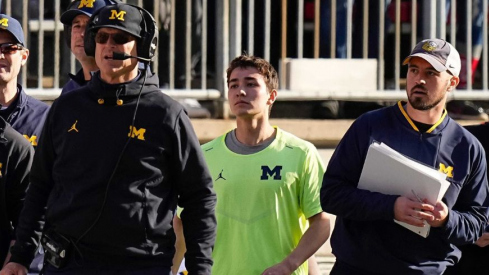
While by no means perfect, the defense's performance against Purdue was a noticeable upgrade, both in execution and outcome. It was the Buckeye defense that kept Ohio State in the game, in spite of special teams breakdowns and offensive turnovers. The OSU defense was able to improve its performance through a combination of key additions in leadership and talent, significant improvements in performance from stalwarts, and a slight change in scheme that allowed Ohio State to get off the field on third down. This permitted OSU to hang around long enough to stage its comeback.
Bad Juju
Of course any observer would be excused for failing to believe that would be the case after the game's first play. Purdue's 83-yard touchdown was a result of the same issues that have plagued OSU this year, namely uncertainty in executing the Buckeyes' cover-4 scheme. Purdue clearly implemented this play to take advantage of this confusion. Purdue lined up in the same twins to the field, tight end to the boundary formation that has troubled OSU's cover-4 all year. The Boilermakers ran two inside posts with a fullback wheel route and tailback flat. To that side, OSU had CB Travis Howard responsible for No. 1, S CJ Barnett responsible for No. 2, with nickel Orhian Johnson and Mike Storm Klein responsible for Nos. 3 and 4.

But as it happened, Johnson and Klein both initially committed to the tailback's flat route. This allowed the fullback's wheel to come free, leading to an untouched score.
Admission is the first Step...
Despite this inauspicious beginning, the Buckeye defense rebounded, improving as the game moved forward. Part of this success relative to Indiana the week before was personnel. Nate Williams' return was one such improvement. Williams' versatility and leadership were well needed tonics. Williams' versatility also paid dividends in allowing OSU to get their 'best 11' on the field. With Josh Perry's injury, Williams began playing Sam linebacker in Ohio State's base defense. Though he got lost at times in pass coverage (including Purdue's 31 yard touchdown on a screen), his physical presence on the edge was a sizeable improvement, particularly against Purdue's inverted veer run game. Williams' ability to play Sam allowed the Buckeyes to play Noah Spence at Leo. Spence is quickly living up to his potential. In particular, he has quickly improved his ability to play against the run from earlier this season.

In nickel situations, then, OSU was able to use Williams and Spence on the edge, bumping John Simon down from 5-technique to inside. Suddenly, OSU had legitimate pass rushers on the field.
The OSU defense was also buoyed by Zach Boren's presence. One could tell that as Boren became more comfortable he began making plays. And the more minutes Boren played, the better the defense executed as whole. Boren was perhaps the first Buckeye linebacker to play downhill and attack the hole.
He also was the first OSU linebacker to correctly diagnose a play and shoot underneath a gap. He thus was able to take advantage of Simon's play at the point of attack to make a key third down tackle for loss.
By playing downhill, Boren then allows Ryan Shazier to take advantage of his athletic ability to move laterally behind him. Further, not only was Boren's play an upgrade at a position that has been a struggle all year, but he brings additional leadership to the back seven. Look for Boren to continue to fill this role going forward.
Self Scouting
Urban Meyer's infusion into defensive meetings last week led to one perhaps unexpected strategic change. On first and second down, OSU played its standard cover-4 defense. But on third down, OSU went from playing large amounts of cover-1 to quite often featuring a more conservative cover-2.

In fact, OSU was in cover-2 on perhaps their two most important plays—the end zone interception to end Purdue's interminable first half drive,
and the defense's fourth down overtime stop.
The defensive staff ably mixed cover-2 and zone blitzes in overtime, evidencing a change in strategy and keeping Purdue off-balance.
From there, to get both Spence and Williams on the field simultaneously in nickel, the Buckeye coaches largely abandoned the 30-odd front for a standard 4-2-5 over, as seen above.
It is unclear whether this third-down philosophical shift was a reflection of the coaching staff examining their third down failings and trying to adjust to fit their personnel, or was simply a reaction to scouting Purdue. In either case, OSU was more sound. In multiple cases the Buckeye secondary was able to come up and make sound tackles short of the first down. The previously easy first downs for opponents were not readily available.
This change also seemed to put the Buckeye defensive backs in a comfort zone. The OSU cornerbacks adopted a more aggressive posture. This seemed to have a snowball effect, particularly with Travis Howard, who played perhaps his most physical game as a Buckeye. As the game continued, the corners became more aggressive in breaking up pass plays. CJ Barnett also looked far more comfortable and aggressive coming up to make tackles. The result was a more confident and assertive backfield.
What Is Old Is new Again
The Buckeye defense was not simply aided by Williams' return and Spence and Boren's increased reps. Instead, as with Howard, perhaps the most crucial aspect was simply improved play from it stalwarts. While Meyer's discussion of improved leverage may have seemed cliched, it certainly appeared to impact Ryan Shazier and Christian Bryant. Shazier and Bryant are two Buckeye defenders who do have the talent to play have at a high level but have been inconsistent this year, mainly due to poor angles and tackling. But that was not present Saturday. Shazier in particular looked like a different player, repeatedly taking proper angles, maintaining leverage, and making sound tackles (also note how well Spence maintains his outside leverage and spills the running back).
While it is not a sexy issue, this proper leverage is the difference in stopping some of the big plays that have plagued the Buckeye defense.
But perhaps the most dominant performer was John Simon. Simon naturally excels more against the run. Therefore the more a team like Purdue tries to move on the ground, the more effective he becomes. He is especially difficult for a team to run read plays off of, because he is so fundamentally sound yet also athletic enough once the quarterback commits. Purdue's base run play is inverted veer. But as noted, with Williams and Simon on the edge it was extremely difficult for the Boilermakers to execute.
But Simon was also dynamic pass-rushing against the Boilermakers. With Spence and Williams on the edge the Buckeyes moved Simon inside on third downs and gave Simon a two-way go. He was repeatedly able to beat Purdue's guards inside, providing OSU a legitimate inside rush. The Buckeyes were also able to stunt and twist far more than they had previously done.
The result was that OSU was able to (finally) generate some pass rush with their front four. This was a crucial change in the Buckeyes' defense and was as important to the improved third down play as coverage changes. The pass rush forced quicker throws, which allowed the Buckeyes' cover-2 defenders to come up and make tackles.
The upshot is that the Ohio State defense played a far more fundamentally sound game. The Buckeyes still occasionally struggled with the wide receiver screens, which is mostly a reflection of their lack of a true star to play to the field against spread sets. But the OSU defense played downhill, maintained leverage, and tackled. While far from perfect, it was a definitive improvement in one week's time from prior outings.
Penn State: Boston on my mind
Penn State will present a slightly different challenge than the Buckeye defense has faced this year. The Nittany Lions are a pro-style team, but unlike Michigan State, they are not a run-first squad. Instead, they are a poor man's version of the New England Patriots. They attempt to move the football with short, ball control passing, such as snag and spacing routes, as well as a large amount of bootleg floods.
Further, Bill O'Brien implemented his Patriot NFL roots (to the extent he can) with this Nittany Lion squad. That means taking the very NFL concept of moving around skill position players to create the oft-coveted 'matchups.' This is crucial to pro teams, where practice time is unlimited and talent differences are small. For New England, this means positioning their all-pro tight ends Rob Gronkowski and Aaron Hernandez anywhere on the field. O'Brien brings this same idea to bear at Penn State. For instance, beginning at the 2:15 mark below, Penn State runs one play were TE Kyle Carter is in the slot and the next where he is split wide.
O'Brien has also brought the Patriots' no-huddle to college football (the place where Belichick looked for no-huddle concepts).
The Buckeye defense should be prepared to face a no-huddle team, given that they faced one throughout the pre-season. O'Brien will assuredly try to move around Carter and Bill Belton to create plays in the flat, where the OSU defense has been susceptible. But Penn State has not run the ball well this year and OSU must render them one-dimensional. From there, OSU can focus upon continuing what they did on third down this week and creating a pass-rush with their front four. The Buckeyes can live with some short completions so long as they continue to come up and tackle.

